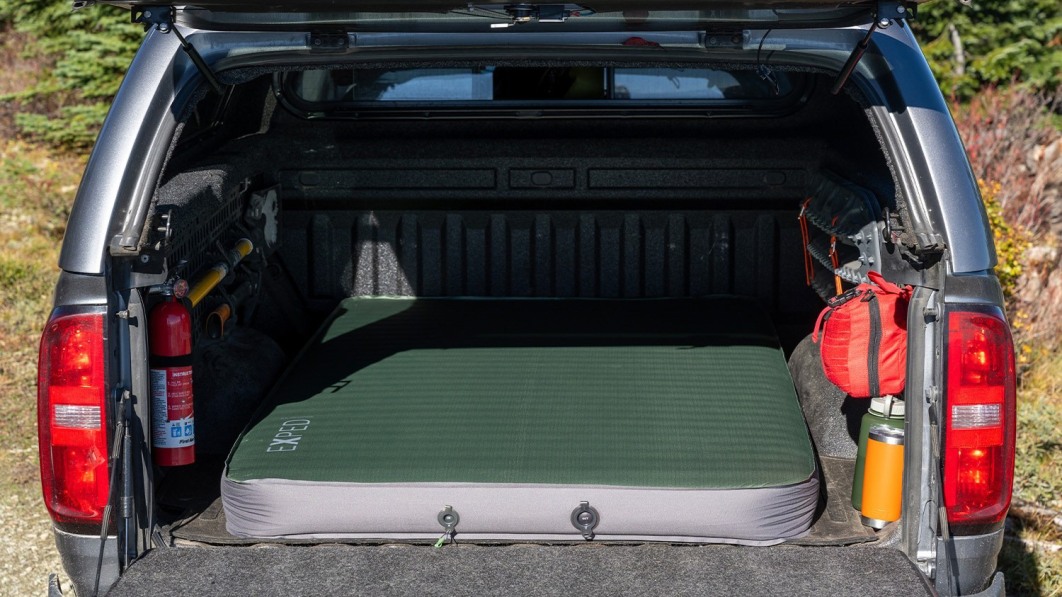Columbia Sportswear EVP Joe Boyle shows a vest with the company’s “Omni-Heat Infinity” thermal liner in front of a mock-up of Intuitive Machines’ Nova-C lander.
CNBC
CNBC’s Investing in Space newsletter offers a view into the business of space exploration and privatization, delivered straight to your inbox. CNBC’s Michael Sheetz reports and curates the latest news, investor updates and exclusive interviews on the most important companies reaching new heights. Sign up to receive future editions.
Overview: Sweater weather
One theme I’m always keeping an eye on as a business reporter is whether companies outside the space sector are tapping the industry’s products, services or even just advertising opportunities. We’ve talked a lot about this topic in relation to space networks like GPS, communications and imagery – but last week’s historic moon landing represents yet another example.
Looking at Intuitive Machines‘ Odysseus spacecraft, you may have noticed any one of four fairly visible images: The American flag, NASA logo, Intuitive Machines logo … and a Columbia Sportswear logo.
“Back in the spring of 2021 … we ended up getting an inquiry that was, in my view, so strange that I had to follow up,” Joe Boyle, President of Columbia Sportswear and an Executive Vice President of Columbia Sportswear Company, told me.
The concept was pretty simple, if ambitious: Take Columbia’s “Omni-Heat Infinity” thermal reflective fabric – already inspired by the classic space blanket – and apply it to Intuitive Machines’ Nova-C spacecraft to protect it against the harsh extreme environment of space, where temperatures swing wildly from -250° to 250° Fahrenheit.
A closer look at the “Omni-Heat Infinity” thermal liner.
CNBC
“A lot of what we do is focus on innovation for humans in the outdoors, and those innovations we come to find out are highly useful in other applications like space,” Boyle said, adding that the project was “not just a logo on the side of the lunar lander. This is actually some innovation that can make a difference.”
While Intuitive Machines and Columbia have yet to release data on just how well the tech worked, they used the apparel maker’s tech to cover a panel on the lander, as well as to wrap its fuel tanks. And the results speak for themselves: While Intuitive Machines faced a number of other challenges during the mission, the lander survived about a week traveling through space and operated for several days on the moon — without apparent temperature challenges.
“We’re looking forward to learning about all the details of the mission to make the next mission even better,” Boyle said.
Of course, Columbia wasn’t just involved to keep a moon lander comfortable with its jacket liner. The brand exposure that comes with being a marquee partner on the mission was “as good as it could have been,” Boyle emphasized, because “yeah, our technology is now on the moon.”
“A technology that’s good enough to get a lunar spacecraft to the moon, that you can wear in your everyday life? It’s hard to beat that in terms of qualification,” Boyle said.
“This is one of the most interesting things I’ve ever worked on, for the brand and the company. Pioneers in space – I would have never attached that to our company, say, 5 years ago,” Boyle added.
What’s up
- FAA and SpaceX close mishap investigation into Starship’s second flight test: “SpaceX identified, and the FAA accepts, the root causes and 17 corrective actions.” SpaceX is implementing the corrective actions, and the FAA is evaluating the next launch license. – CNBC
- Intuitive Machines’ lander Odysseus sent back its first photos from the moon after its historic landing. A dramatic image shared later showed the lander as it touched down on the moon, with the spacecraft’s engine firing and part of the landing gear visibly broken. – CNBC / Intuitive Machines
- A dead Russian spy satellite and a NASA environmental satellite had a near miss. Orbital tracking company LeoLabs reported the two non-maneuverable spacecraft came within 20 meters (65 feet) of each other. The company noted that “this event is notable because it is rare. In the last two years, there have been only 6 events with a miss distance of < 20 m between two intact, non-maneuverable objects.” – LeoLabs
- NASA and SpaceX recently performed a qualification test of a Starship docking system, which will be used to dock with the Orion capsule or Gateway station in lunar orbit. The agency also noted that “SpaceX has completed more than 30 HLS specific milestones.” – NASA
- Japan’s SLIM lander survived lunar night, with its space agency announcing the resumption of communication with the spacecraft and began sharing new photos from the mission, which was expected to end after lunar night began. – JAXA / JAXA
- Varda releases video of its capsule’s reentry from orbit, showing the spacecraft separate from Rocket Lab’s Photon satellite, reach speeds over Mach 25, and then touch down under a parachute in the Utah desert. – Varda
- India announces the four astronauts that will fly on the country’s first crewed launch. – Reuters
- Space Force to make fixed-price contract exception for high-priority communications satellites: The military branch is preparing to open bidding for the Evolved Strategic Satellite Communications System (ESS) program, which is estimated to be worth $8 billion. – SpaceNews
- Flawless Photonics produced a record amount of ZBLAN optical fiber on the space station, with the startup announcing it manufactured more than 5 kilometers worth on the International Space Station in two weeks. NASA representatives called the achievement “a class by itself” and “unprecedented.” – SpaceNews
- Northrop Grumman warns space unit of forthcoming layoffs, filing notices in California that will reportedly impact about 1,000 employees. – SpaceNews
- Astranis relocating first but limited satellite Arcturus in orbit to instead provide services over Asia, instead of Alaska, since a malfunction with its solar arrays has hampered the satellite’s ability to provide service. Astranis CEO John Gedmark said Arcturus will be used on “a multimonth mission to secure valuable spectrum rights” for Israeli operator Spacecom. – Gedmark
- SpaceX lands a second Falcon 9 rocket booster 19 times, as the company continues to push the boundaries of reusability. – Watch
Industry maneuvers
- French startup Unseenlabs raises $92 million (€85 million) in a round led by Supernova Invest, ISALT and UNEXO, and joined by 360 Capital, OMNES, Bpifrance, Breizh Up and S2G Ventures. The company currently has 11 ship monitoring satellites in orbit, and plans to deploy more. – Unseenlabs
- Firefly expands ‘Rocket Ranch’ facility in Briggs, Texas, with a ribbon cutting of a manufacturing space that is now 207,000 square feet for rocket production and assembly. – Firefly
- Redwire opens new Colorado facility that expands its footprint in Longmont to over 65,000 square feet for manufacturing and testing, saying the facility will help ramp up its production of hardware for national security missions. – Redwire
- Astra cofounders submit lower bid to take company private, slashing their offer to 50 cents a share from $1.50 a share in November. – Astra
Market movers
- Rocket Lab’s backlog surged above $1 billion, it said in its Q4 report, with a major Pentagon satellite contract and a record year for launch deals driving the growth. The company reported a net loss of $50.5 million for the quarter, up 36% year over year, as it continues to spend heavily to develop its Neutron rocket. – CNBC
- SES reports $2.2 billion (€2 billion) in 2023 revenue, up about 4% year over year and driven by growth in its mobility unit that saw revenue gains from cruise ship services as well as expansion in revenue from government customers. – SES
- Virgin Galactic reports Q4 results and prepares for spaceflight hiatus as it turns its attention to development and production of its next-generation Delta line of spacecraft. – Virgin Galactic
- Globalstar had a ‘record year’ in 2023, the company said in its Q4 results, as its annual revenue jumped 50% year over year to $224 million. But the company expects that trend to level out this year, forecasting revenue between $225 million to $250 million for 2024. – Globalstar
Boldly going
- Tony Frazier brought in as CEO of LeoLabs: Frazier joins after leaving as a senior Maxar executive, with LeoLabs cofounder Dan Ceperley vacating the role to become COO. – SpaceNews
- Dana Weigel and Joel Montalbano promoted at NASA, as Weigel succeeds Montalbano as manager of the International Space Station program, and Montalbano moves on to be deputy associate administrator for the agency’s Space Operations Mission Directorate. – NASA
On the horizon
- Mar 1: EchoStar reports Q4 results before the bell.
- Mar 2: SpaceX Falcon 9 launches Crew-8 mission for NASA from Florida.
- Mar 3: SpaceX Falcon 9 launches Starlink satellites from Florida.
- Mar 4: SpaceX Falcon 9 launches Transporter-10 rideshare mission from California.


/cdn.vox-cdn.com/uploads/chorus_asset/file/25289835/247019_Garmin_Lily_2_AKrales_0030.jpg)




